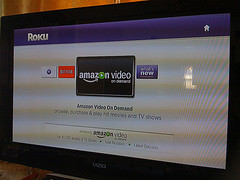
- Image by programwitch via Flickr
For the first installment of Downstreaming, we’re going to explore Amazon Video On Demand as an option for acquiring content.
Amazon Video on Demand, formerly known as Amazon Unbox, is Amazon’s video streaming service. It is not subscription based. It is an ala-carte video service that offers both rental and purchase. You can also purchase passes to TV shows and receive a discount.
Amazon VOD support is built into the Roku Box, Google TV, Tivo, and select televisions and blu-ray players. You can also stream it using Adobe Flash on a computer. It offers both SD and HD rentals. We’re just waiting for an HTML5 version, and iOS and Android apps for the mobile platforms.
We decided to give it a shot, taking advantage of an offer for the popular movie Inception for 99 cents for a 48 hour rental. It included a $4 credit if we choose to buy the movie afterward. Video acceleration on the Linux version of  Adobe Flash can sometimes lag a bit, so we used a Roku Box to test the service. The movie playback was great, and there is a good selection of daily/weekly/monthly deals and some free content.
One of the nicest value added additions Amazon VOD offers is Disc+ On Demand. This is an Amazon program for those who purchase physical media. On select discs, you will automatically get a digital version of your purchased movie in your Amazon Video on Demand library. The problem is, so far, in movies we’ve bought, this is a limited time rental. We think many people would pay extra for a movie, or a premium to get disc plus digital copy provided by Amazon VOD.
Many movies are now being bundled with a digital copy that is time limited. An Amazon VOD redemption option with each movie seems like a better idea for studios, even if it is only a discount on getting the streaming copy. Teleread, for example, recently commented on how the code to use the digital copy included with the latest Star Trek movie expired…before they had purchased the movie. Yet the discs are still being bundled. The issue with buying content…excuse us…licensing content that is stored in the cloud is if the service provider ceases to provide the service. Then…what do you own?
Amazon VOD, in their terms of service, states, “Purchased Digital Content will generally continue to be available to you for download or streaming from the Service, as applicable, but may become unavailable due to potential content provider licensing restrictions and for other reasons, and Amazon will not be liable to you if purchased Digital Content becomes unavailable for further download or streaming.” We would feel more comfortable if, like their Kindle scandal a while back, Amazon was forced to ensure that even if they can no longer sell an item, that anyone who purchased it is still entitled to enjoy it in perpetuity, as the term “Buy” implies. But, for rentals, the service is a good alternative.
Related articles
- Amazon Disc+ On Demand gets 10,000 new titles (slashgear.com)






![Reblog this post [with Zemanta]](http://img.zemanta.com/reblog_e.png?x-id=702fbfeb-2eaf-4e42-ae89-8ffee00bbd14)